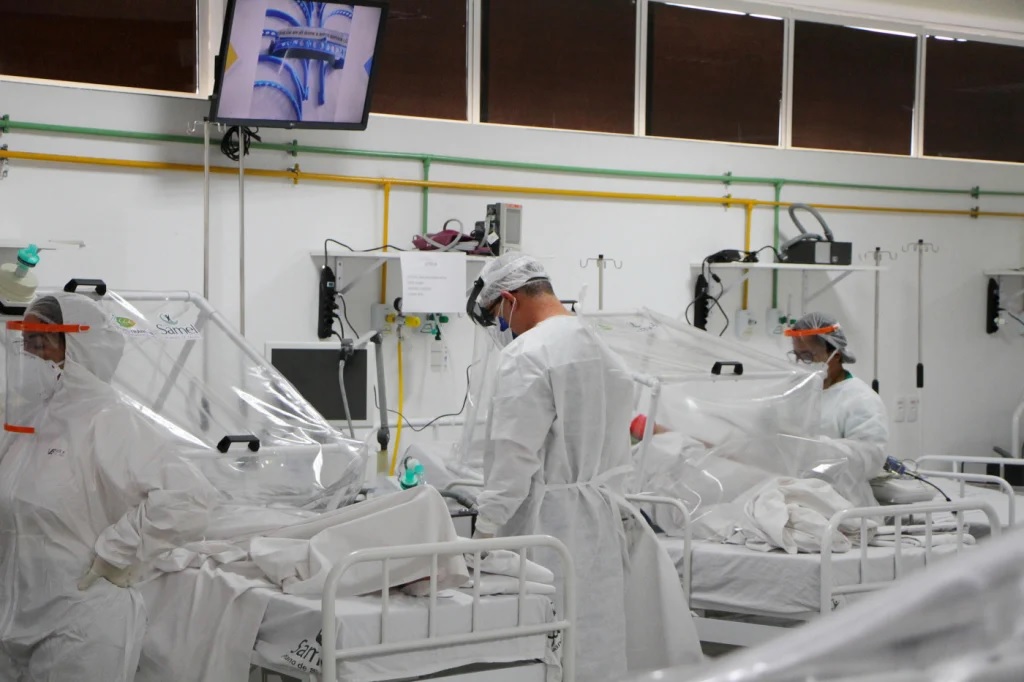RIO DE JANEIRO, BRAZIL – ICU bed occupancy for critically ill Covid-19 patients in Brazil is once again of concern, particularly in the three southern capitals that at the start of the pandemic had relative control of the disease, and in Vitória, Espírito Santo.
Hospitalizations in Manaus, a city whose mass burial images in collective graves spread around the world, have also increased again.
In at least six capitals (Vitória, Florianópolis, Porto Alegre, Curitiba, Manaus, and Rio de Janeiro), ICU state hospital beds occupancy reaches or exceeds 80 percent, according to a Folha de S.Paulo survey with city halls and state governments.

The figure could be even higher, as Recife and Macapá have failed to report data, but their states show high occupancy rates of over 70 percent – and ICU beds tend to be mostly concentrated in state capitals.
In the South, there is an excess of critically ill Covid-19 patients in all capitals. The ICU bed occupancy in Florianópolis (SC) stands at 87.76 percent, in Porto Alegre (RS) at 85.39 percent, and in Curitiba (PR) at 82 percent.
In Paraná state, 56 percent of ICU beds have received patients with the disease, but in Curitiba, some private hospitals are working at full capacity.
Faced with the spread of the pandemic in the city, the city has suspended elective surgeries, but has also authorized the return to classes of children under ten years old in private schools. Retail trade also remains open in the capital. In-person public, state, and municipal education, however, tends to be resumed next year only.
Santa Catarina has seen an increase in the number of infections. In the state, ICU occupancy on Tuesday stood at 75.66 percent, and Florianópolis is at a “very serious risk”. Over the last extended holidays, beaches were crowded, which influenced the emergence of a second wave of Covid-19 in the city.
Interim Governor Daniela Reinehr was diagnosed with Covid-19 last week. She had deleted from her social networks a message urging the population to wear masks.
Rio Grande do Sul had 74.9 percent of its ICUs occupied. In the capital of Rio Grande do Sul, where occupancy stood at 85.39 percent, some hospitals are full, such as the Moinhos de Vento, according to city hall data.
Porto Alegre had been considered a “high risk” region in the map released by the government last Friday, November 13th. However, after the municipality appealed, the government considered the capital of the state of Rio Grande do Sul as “average risk,” without restricting services and economic activities.
The capital’s mayor, Nelson Marchezan Jr. announced on Tuesday, November 17th, that his test had come back positive for Covid-19. “My symptoms are mild and I am at home, complying with isolation. I take this opportunity to again urge the people of Porto Alegre not to neglect the protocols and, if they feel any symptoms, to seek our healthcare network,” wrote Marchezan on social media.
In the Southeast, the metropolitan region of Vitória, Espírito Santo state, is the most crowded with Covid-19 patients in the country, with an 87.8 percent occupancy rate of its ICUs. The network combines public and private, philanthropic and federalized beds hired or outsourced by Renato Casagrande’s management. The state recorded 172,924 cases and 4,037 deaths related to the disease.
In Amazonas, all ICUs are concentrated in the capital, the first to see its health network collapse. While the state’s bed occupancy rate has increased, currently at 82 percent, the number of beds exclusively dedicated to the disease has been reduced from 223 to 142 since August.
Last Tuesday, November 17th, Manaus passed the 3,000 death mark in the pandemic. That same day, the Manaus City Hall issued a decree that will keep the Ponta Negra beach, the capital’s main public beach resort, closed until December 31st.
The neighboring state of Pará is among the states that most reduced its beds for the disease in the pandemic. In the capital, Belém, the occupancy rate stands at 73 percent, but in general, beds spread across the state maintain a rate of 50 percent.

In Rio, the increase of the disease has once again become a concern. In the capital, 80 percent of the approximately 520 public ICU beds (sum of municipal, state, and federal networks) were full last Tuesday, November 17th. If only the municipal network were considered, occupancy stood at 97 percent. Of the 251 municipal beds in the capital, only eight are vacant.
The surge led the Municipal Health Secretariat to send an internal letter to the city’s primary care coordinators last week: “We are experiencing a significant increase in the number of cases of influenza syndrome, confirmed Covid-19 cases and hospitalizations in recent weeks,” the statement alerts.
The occupancy is also owed to the reduction in beds over the past months. The only field hospital remaining was municipal one, since governor Wilson Witzel had closed all the state units. The federal government also disabled the few beds available at its Bonsucesso Hospital following a fire in October.
In São Paulo, bed occupancy increased in November from 40 percent at the start of the month to 43 percent. Hospitalizations in general, which include patients in wards and ICUs, stood at 6,650 at the start of the month and on Monday, November 16th, stood at 7,705. The figures refer to the rolling average in the seven days up to the referred date.
However, ICU occupancy is still lower than recorded in the last survey, on August 10th; on that date it stood at 59 percent both in São Paulo state and capital. In São Paulo capital, occupancy stood at 52 percent on Monday.
In the Midwest, formerly with low rates of critically ill patients, Campo Grande, Mato Grosso, last week recorded a 76 percent ICU occupancy. If SUS (Unified Health System) beds alone were considered, the rate reached 83 percent, but the city government uses privately hired beds to address Covid-19 hospitalizations. In the state, the situation is better, with an ICU occupancy rate of 29 percent.
In Amapá, a state that has been experiencing a chaotic power outage in recent weeks, the pandemic is also advancing. A total of 79 percent of ICU beds for Covid-19 are occupied in the state, which has canceled elective surgeries during the power outage.
Minas Gerais, which does not separately disclose SUS general beds reserved for Covid-19, has 62.9 percent of its ICU beds occupied -18.3 percent of which with cases related to the disease by Wednesday. Minas recorded 387,751 confirmed cases and 9,605 deaths by Wednesday, November 18th.
Belo Horizonte, the capital of Minas Gerais, has 33.5 percent of its ICU beds for Covid occupied. According to infectologist Carlos Starling, member of the municipal government’s committee to tackle Covid-19, there is no indication of a new lockdown in the capital of Minas Gerais, which remains under some restrictions in terms of days and schedules. The criteria for opening schools, he says, was set at less than 20 cases per 100,000 inhabitants as a safety parameter.
Over the past ten days, Pernambuco state was again required to mobilize ICU beds for patients with severe acute respiratory syndrome due to the increase in cases. On November 7th, the ICU/Covid bed occupancy rate stood at 81 percent and again became a concern for health authorities.
The government expanded bed offer last week. It rose from 780 to 833. On Tuesday, November 18th, 73 percent of the 833 beds were occupied. In early August, the rate stood at 63 percent of the 868 beds.
The Midwest has more controlled levels, Cuiabá (29 percent bed occupancy) and Goiânia (42 percent), as do some capital cities of the Northeast, such as Maceió (rates of 26 percent), São Luís and Aracaju, both at 37 percent. Palmas (Tocantins) is the location with the lowest rates for the disease, with only ten percent of its 76 beds being used for Covid-19 patients.
Source: Folhapress

